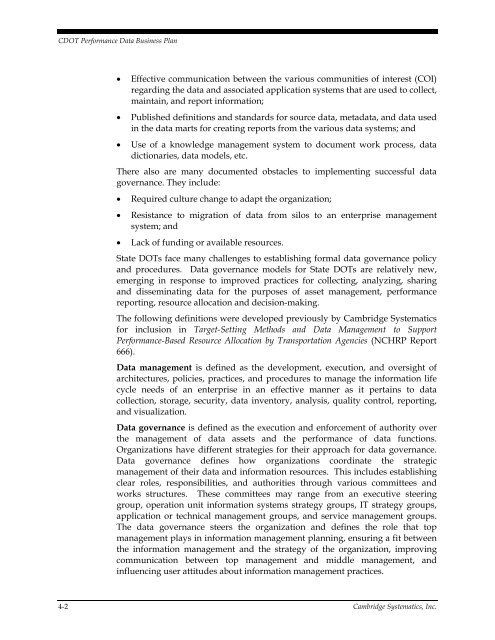CDOT Performance Data Business Plan - Cambridge Systematics
CDOT Performance Data Business Plan - Cambridge Systematics
CDOT Performance Data Business Plan - Cambridge Systematics
Create successful ePaper yourself
Turn your PDF publications into a flip-book with our unique Google optimized e-Paper software.
<strong>CDOT</strong> <strong>Performance</strong> <strong>Data</strong> <strong>Business</strong> <strong>Plan</strong><br />
<br />
<br />
<br />
Effective communication between the various communities of interest (COI)<br />
regarding the data and associated application systems that are used to collect,<br />
maintain, and report information;<br />
Published definitions and standards for source data, metadata, and data used<br />
in the data marts for creating reports from the various data systems; and<br />
Use of a knowledge management system to document work process, data<br />
dictionaries, data models, etc.<br />
There also are many documented obstacles to implementing successful data<br />
governance. They include:<br />
<br />
<br />
<br />
Required culture change to adapt the organization;<br />
Resistance to migration of data from silos to an enterprise management<br />
system; and<br />
Lack of funding or available resources.<br />
State DOTs face many challenges to establishing formal data governance policy<br />
and procedures. <strong>Data</strong> governance models for State DOTs are relatively new,<br />
emerging in response to improved practices for collecting, analyzing, sharing<br />
and disseminating data for the purposes of asset management, performance<br />
reporting, resource allocation and decision-making.<br />
The following definitions were developed previously by <strong>Cambridge</strong> <strong>Systematics</strong><br />
for inclusion in Target-Setting Methods and <strong>Data</strong> Management to Support<br />
<strong>Performance</strong>-Based Resource Allocation by Transportation Agencies (NCHRP Report<br />
666).<br />
<strong>Data</strong> management is defined as the development, execution, and oversight of<br />
architectures, policies, practices, and procedures to manage the information life<br />
cycle needs of an enterprise in an effective manner as it pertains to data<br />
collection, storage, security, data inventory, analysis, quality control, reporting,<br />
and visualization.<br />
<strong>Data</strong> governance is defined as the execution and enforcement of authority over<br />
the management of data assets and the performance of data functions.<br />
Organizations have different strategies for their approach for data governance.<br />
<strong>Data</strong> governance defines how organizations coordinate the strategic<br />
management of their data and information resources. This includes establishing<br />
clear roles, responsibilities, and authorities through various committees and<br />
works structures. These committees may range from an executive steering<br />
group, operation unit information systems strategy groups, IT strategy groups,<br />
application or technical management groups, and service management groups.<br />
The data governance steers the organization and defines the role that top<br />
management plays in information management planning, ensuring a fit between<br />
the information management and the strategy of the organization, improving<br />
communication between top management and middle management, and<br />
influencing user attitudes about information management practices.<br />
4-2 <strong>Cambridge</strong> <strong>Systematics</strong>, Inc.

















